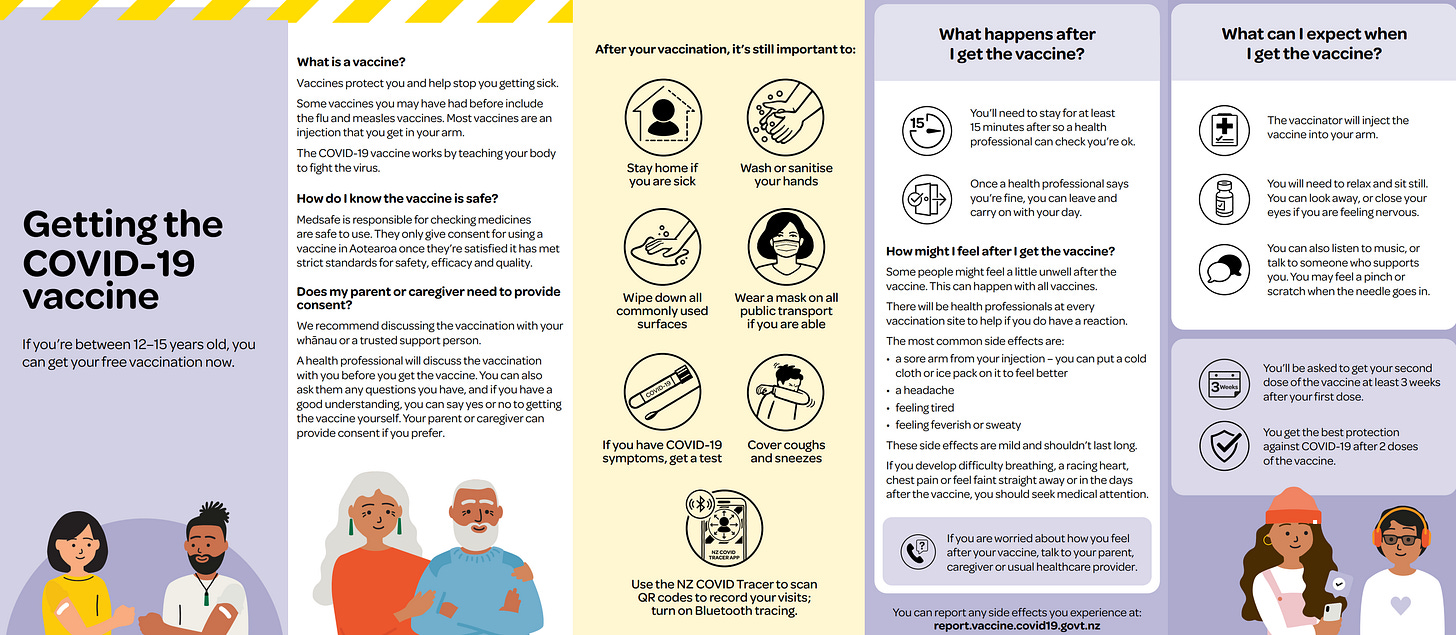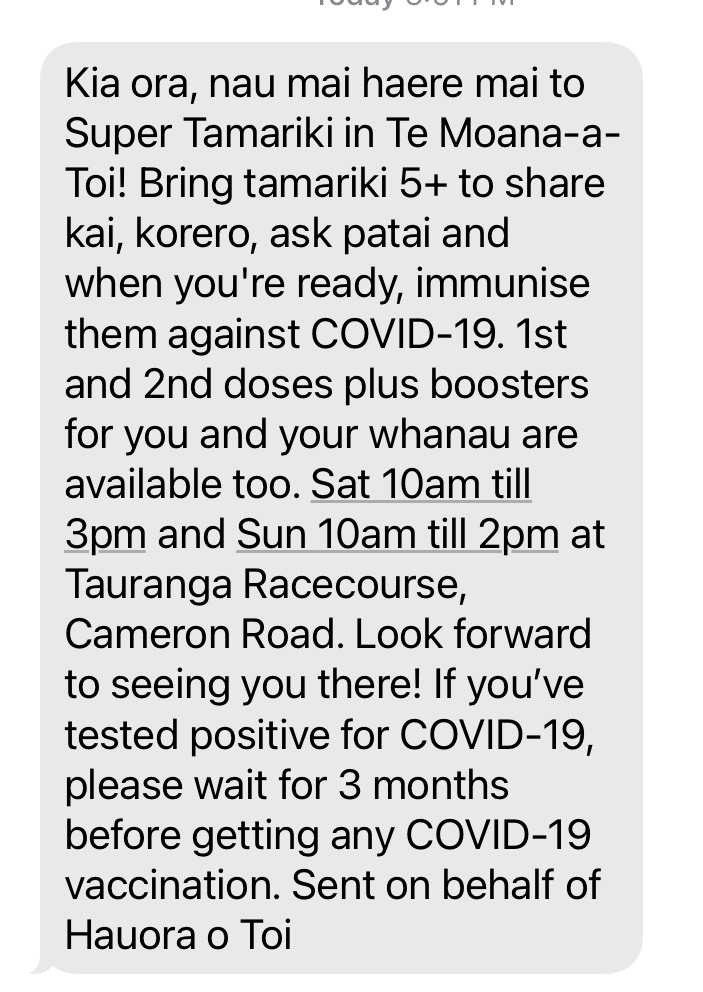Emergency Powers: [7] Vaccine as (toxic) vector for authoritarian policies
From my April 2022 paper COVID-19 Emergency Powers: The New Zealand State, Medical Capture & the Role of Strategic Ignorance
Chapter 7
In March 2021 the Ardern government signed a contract with Pfizer that secured the capability for the state to vaccinate the entire population. From this early stage, Prime Minister Ardern directly associated receipt of the genetic vaccine with freedom, stating
‘With every person who gets vaccinated, New Zealand gets one step closer to moving away from restrictions to manage COVID-19.’
Earlier supplies had arrive the month before, with the vaccine rollout commencing in February 2021 with border and MIQ workers the first citizens to be injected.
Vaccine mandates were predicated on a fundamental assumption - that vaccination would be the primary, i.e. only treatment, and hospitalisation and/or death were unlikely to be prevented unless the medical treatment was accepted by all New Zealanders. No early treatment was offered.
No virus has ever been controlled without authorities accounting for the role of herd immunity. A vaccine for a respiratory coronavirus was always going to involve uncertainty. The history of coronavirus vaccine development from the 1960’s was peppered with failure, and antibody dependent enhancement and the specific risk of cardiomyopathy related to coronaviruses had been recognised in earlier coronavirus vaccine research. The ‘vaccine’ involved the deployment of novel uncertain technology, instead of standard 3-year trials, the FDA permitted Pfizer to terminate the BNT162B2 study after 6 months, and then offered the vaccine to the placebo recipients, muddying the trial.
Efficacy for the BNT162B2 was derived by success in preventing occurrence of symptoms of the respiratory infection. Efficacy did not consider the overall prevention of hospitalisation and death, nor contrast the adverse event rate in order to establish the cost-benefit ratio of risk following injection. It's important to note that potential for prevention of transmission of infection was never studied in the mRNA genetic vaccine clinical trials. Efficacy for Medsafe, was determined by the results of the clinical trials, including the trials for the Pfizer BNT162b2 genetic vaccine, the major endpoint of which was an immune response generated by the vaccine in a 7 and 14 day window.
From an early stage the vaccines could not produce sterilizing immunity, nor prevent transmission of infection (Ed. here and here and here and here and here) and circulating Sars-Cov-2 was likely to generate mutants (see discussion p.70).
The scientific implication of this early understanding should have been firstly, to immediately recognise that viral replication of circulating variants would be disinhibited by herd immunity. Vaccinated populations carried a double-edged risk, if they were likely to experience inflammation/autoimmune risks, this would make them more vulnerable to future Sars- Cov-2 variants. The second implication was that highly vaccinated populations where immune systems are impaired already, might produce the conditions where the virus could become increasingly harmful (pathogenic priming, or antibody dependent enhancement). As Danish researchers stated:
‘Variants of concern have typically been the result of persistent infections in immunocompromised people that can cause the virus to mutate more frequently because the person's immune system cannot clear the virus as quickly as the immune system of a healthy person.’
In addition, the technology posed distinct risks with the insertion of a self-replicating spike protein into humans. There was tremendous prospect for spike-protein driven inflammation; early studies had previously acknowledged a coronavirus-myocarditis connection, and there was evidence that a foreign protein would spur autoimmune reactions in cells.
This knowledge was never discussed in New Zealand, nor was herd immunity debated. The New Zealand government urged families to get vaccinated to protect whanau, inferring this would prevent transfer of infection, prevention of transmission of infection was never an endpoint to secure approval for the novel mRNA genetic vaccine. However, from at least October 2021 there was substantial evidence (and here) that contradicted this claim, indicating that the mRNA injection did not meaningfully prevent transmission (see above plus here and here).
As of April 1, 2022, texts are still being sent out urging all who are 5 and up to get vaccinated.
There is no established signal – no red line – established by either Medsafe or the other adverse event database management institutions, when consent for the provisional (and emergency) approvals would be withdrawn due to an excess of hospitalisation and death following injection.
Historically, in the USA, five unexplained deaths would result in a black-box warning, while 50 deaths would result in withdrawing a drug. Safety signals need not accrue before investigation, as the FDA has acknowledged,
‘it only takes a single well-documented adverse event to justify a safety signal investigation’.
The capture of all people under mandates, includes pregnant women. Historically, medicines for pregnant women, particularly to novel technologies, have been regarded cautiously. Pfizer/Biontech acknowledged that use in pregnancy and lactation and vaccine effectiveness are areas identified as missing information.
Requiring pregnant women to be vaccinated in order to be employed was a significant shift from earlier cautious approaches. However, the Immunisation Handbook (January 2022 version), in advising pregnant women were not medically exempt from vaccination, stated (on p.191):
‘[p]regnancy is associated with higher risk from COVID-19 compared to the general population and therefore this group are a priority for vaccination.’
The Handbook cited a study which did not consider risk stratified by health (multimorbidity) status.
From April 2021 published literature confirmed (COVID-19) risk in pregnancy aligned with multimorbidity and socio-economic status. Despite this information being available, all pregnant women were captured under global mandate regulations.

CHILDREN AND YOUNG PEOPLE
An increasing body of evidence suggests that children and young people are now more at risk of vaccination than Covid-19, particularly if they have had a previous Sars-Cov-2 infection. The Unite Against COVID-19 Campaign and the traffic light system directly coerced healthy young people and children to accept the novel genetic vaccine.
Young people who are not at risk of Covid-19, were required to accept the ‘jab’ in order to work until April 2022, and children over 12 were required to be vaccinated in order to engage in activities. Although not compulsory, high schools were asking parents to identify whether their teenager was vaccinated.

There have been no nuanced discussions to help the public, state employees, elected members or the judiciary negotiate the uncertainty. The result of the traffic light nudge campaign was to ensure that places of community gathering and human connection have been interdit - forbidden. While the large commercial retail outlets and liquor stores remained exempt – the taken-for-granted places of community: libraries and swimming pools, cafés, universities, campsites in national parks, even Parliament, required a vaccine pass to enter. For young people, for whom connection and social contact is essential, there was no question they should take the mRNA vaccine if they were to socialise with friends.
Throughout the mandate and vaccine pass phases, the potential for the injection to prevent transmission of infection (as with some childhood vaccines) was simply not studied in New Zealand.
Early modelling demonstrated that young people and children were not at significant risk of hospitalisation or death (here and here). Children are at low risk of hospitalisation and death and primarily healthy children aged 5-11 in Delta had an extremely low risk of ICU admission, at .2/10,000.

From early on, it was recognised that children and young people who were at risk, were more likely to have associated medical morbidities. A recent study demonstrated that all adolescents that died had medical morbidities. U.S. data suggests that 33% of children may fit in this category, and that 70% of children hospitalised for Covid-19 have one or more medical morbidities.
For those at risk, any benefit from vaccination now that Omicron is in New Zealand, may be short lived. There are options other than mRNA vaccination to manage Sars-Cov-2 infection, and preventative treatment specifically targeted to high-risk children and young people was published in August, 2021.
Young men are at particularly high risk from vaccination. Krug et al (2022) applied 2 different analytical processes to assess risk in adolescents. The first risk-benefit analysis considered gender, health status and looked at risk by Delta and Omicron variants.:
‘For adolescent boys without medical comorbidities, their risk of post- vaccination dose two myo/pericarditis exceeded their risk of COVID- 19 hospitalization during delta after one dose of vaccination. During omicron, the additional benefit of the second dose cannot be estimated due to the reduced VEH [Vaccine effectiveness against hospitalization] with dose two compared to dose one.
Our risk- benefit analysis also does not favour the second dose, or even one dose, in all boys 12– 17 with a history of infection. However, clinicians are cautioned to consider the specific risks associated with the child's health circumstances in their guidance. In girls with or without medical comorbidities, our risk- benefit analysis does not favour two doses if they have a history of SARS- CoV- 2 infection.
By some estimates, even a first dose after previous infection is not favourable for girls 12– 17 without comorbidities.’
The second analysis considered the 120-day hospitalisation rate:
According to our VAERS estimates, the myo/pericarditis risk for a 12– 15- year- old boy without a comorbidity receiving his second dose of the vaccine is 2.8x higher than his 120- day risk of hospitalization even without adjusting for 40% 31- 34 incidental hospitalizations. For older boys, the risk of myo/pericarditis is 1.6x their cumulative 120- day hospitalizations. For those with medical comorbidities, the 120- day COVID hospitalization rates are higher than their rates of myo/pericarditis during times of moderate to high incidence if not adjusting for a possible 40% overestimate of hospitalization rates.) During times of very high incidence, such as the omicron wave, the 120- day risk of COVID- 19 hospitalization for boys with a medical comorbidity is 1.7x- 3x higher than their risk of vaccine- associated myo/pericarditis and is approximately equivalent to their post- vaccination myo/pericarditis risk after adjustment for incidental admissions.’
(Note. There is no special flyer for young people describing their elevated risk from myocarditis in New Zealand.)
The cognitive dissonance required to obediently acquiesce – for both the rulers and the ruled, is monumental.
There was no ‘out’ for children and young people to gain an exemption from mandated vaccination (Note: where they were mandated for sport, education or work, for example), the stories of the Minister of Health and Ashley Bloomfield denying exemptions for vulnerable people who considered that the genetic vaccine posed a health risk are extensive and alarming.
Historically, public health must navigate the conflicts that emerge between privacy and justice, and between different conceptions of justice. This has never been evident in New Zealand’s Unite campaign.
Have you read my Brownstone Institute article?
New Zealand Used Selective Science and Force to Drive High Vaccination Rates
Continue Reading: [8] Practical & Ethical Questions: Vaccination as the primary, mandated treatment here.
References are available on the original PDF at TalkingRisk.NZ


